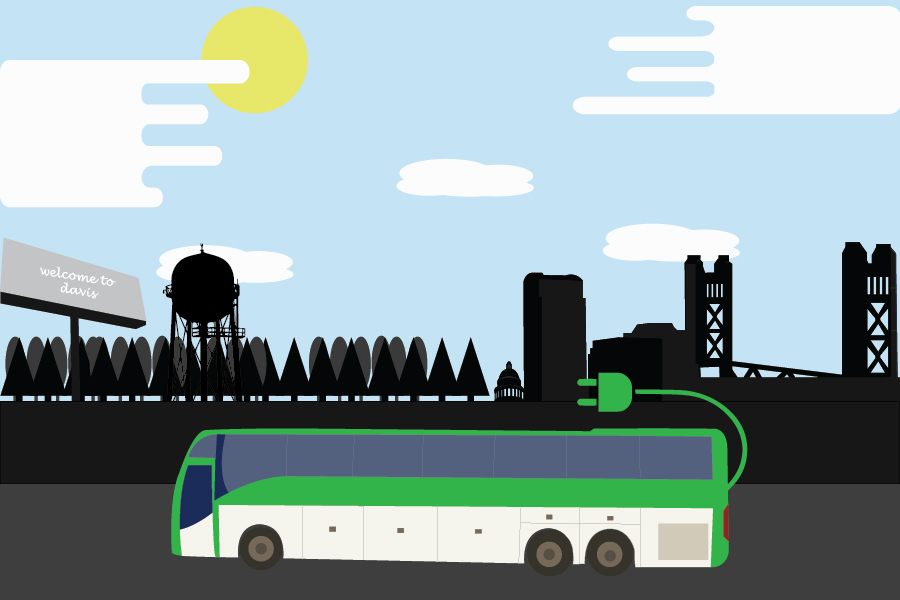
Volkswagen scandal funds to be used for zero-emission bussing in Sacramento, Davis
By 2040, the California Air Resources Board will require transit buses in California to be zero-emission or electric. Changes are now starting as the Yolo County Transportation District looks to partner with the City of Sacramento, City of Davis, City of West Sacramento, University of California, Davis and the Sacramento Regional Transit District to provide zero-emission buses funded by the Volkswagen diesel scandal. As part of its punishment for the air pollution scandal, Volkswagen will be spending approximately $44 million promoting electric vehicles in California, having won approval from the California Air Resources Board.
Mark Lonergan, the deputy general manager and the chief operating officer for SacRT, proposed how these zero-emission buses would function.
“These zero emission buses would operate on 15-minute intervals with fast-charging units proposed at both ends of the route,” Lonergan said. “The UC Davis Medical Center in Sacramento currently employs more than 13,000 students and faculty. Providing a frequent connection between the university and the Medical Center just makes good, common sense as we work to provide public transportation that will have a significant impact on traffic congestion and air pollution.”
The buses will provide a more sustainable and efficient way for UC Davis students in particular to access the campus and the city of Sacramento.
“The City of Sacramento Mayor Darrell Steinberg and UC Davis Chancellor Gary May announced in December that they had formed a task force to explore the construction of a new technology and education campus in Sacramento as well as reimagining transit service between the two cities,” Lonergan said.
Lonergan also emphasized how beneficial and eco-friendly the transit vehicles will be, considering they may be accessible by 2030.
“We think zero-emission transit vehicles will help to reduce the amount of pollution generated not only by reducing the number of private vehicle trips, but also by the transit vehicles themselves,” Lonergan said. “SacRT was a leader in clean-fuel transit vehicles with a conversion to compressed natural gas that started in 1993. We are ready for the next step with a total conversion of the SacRT bus fleet to zero-emission buses as early as 2030.”
However, there are a number of different conditions necessary in order to execute the zero-emission plan.
“In order to facilitate the operation of zero-emission vehicles, it is imperative that charging infrastructure be installed,” Lonergan said. “We are proposing to install 12 charging stations in SacRT’s bus yard for overnight charging after peak usage times, when electricity is less expensive. We are also proposing to install fast-charging units at both ends of the route to provide additional battery life and increased range while the electric buses are in revenue service.”
Jose Perez, the senior transportation planner for YCTD, explained how YCTD is involved in bringing zero-emission buses to Yolo County.
“The team has participated in multiple meetings and discussions as well as working with Electrify America to determine the best approach,” Perez said. “It is YCTD’s goal to ensure that the Yolo County jurisdictions and residents are able to directly benefit from the opportunity and to leverage it to help bring YCTD to the forefront of innovative and environmentally sound transportation.”
Perez added that these funds must also be well protected.
“Allocating these funds to safe, reliable and environmentally sound transportation for the region is a very important goal,” Perez said. “YCTD strongly believes the greatest value from this funding source will be obtained through enhancing public transit and transportation, which will lead to increased ridership, reduced congestion and improved air quality.”
Not only will the opportunity benefit YCTD, but it will also serve to accelerate the district’s plans to upgrade and enhance their service fleet.
“YCTD was at the forefront of using compressed natural gas buses to reduce GHG emissions, [as they have been] applying for grant funds [since] 1989, and has always been determined to meet or exceed environmental and health standards and goals,” Perez said. “Zero-emission vehicle technologies will help YCTD further improve its efficiencies, and YCTD will continue to seek opportunities to procure and place into service these types of technologies.”
SacRT and YCTD have similar goals and will be working together to bring the technology to the county.
“We consider SacRT to be an early adopter of environmentally friendly propulsion, and we look forward to the advancement of zero-emission vehicles, not only in transit, but in all industries,” Lonergan said. “Conserving environmental resources is of critical importance for our current population and for future generations to come.”
According to The Sacramento Bee, Sacramento Mayor Darrell Steinberg said in a written statement that he believes the buses will be especially helpful for students looking to commute between the UC Davis campus and Sacramento.
“This will hopefully be a big step toward connecting the UC Davis campus with Sacramento,” Steinberg said. “I look forward to the day — sooner rather than later — when thousands of UC Davis students will have ready, easy and clean transportation options to Sacramento’s urban technology lab.”
Written by: Stella Tran — city@theaggie.org



Great news, but under the VW diesel scandal funding, WHEN will this first wave of eBuses be fleet ready? And HOW MANY under the $44 million settlement?